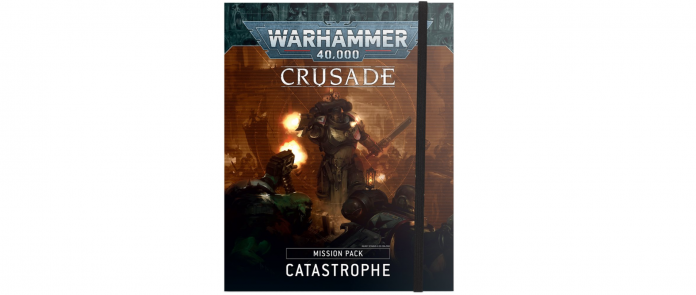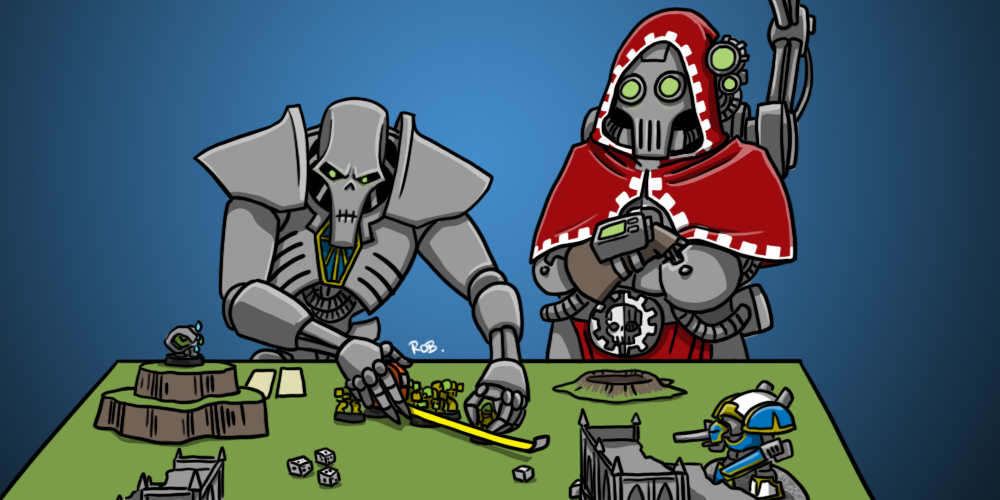As we’ve become accustomed to with the release of a new Warzone Campaign Book, Games Workshop have also released a new Crusade book. Crusade: Catastrophe acts as a companion to the new book, building on some of the themes in the new book, and introduces new rules for playing multiplayer games, as well as rules that reflect a unit’s reputation and how that affects them in battle. So are these new rules worth your time, and will they be the way your group handles multiplayer Crusade missions moving forward? Let’s dig in to find out.
Before we dive into these rules we’d like to thank Games Workshop for sending us an advance copy of the book for review. We’d also like to thank them for making this book spiral-bound so it lays flat. If only all of their books were like this.
Treachery and Honour Battles
Welcome to multiplayer! Multiplayer games – usually 2v2 – have been a part of 40k casual play since the game’s inception, and the Treachery and Honour book finally brings those rules to 9th edition and Crusade proper. Treachery and Honour rules assume four players, but can also work for playing with three. When you’re figuring out Crusade Blessings in these games use the highest total among all players in the game.
Beanith: It does say 4 players on the box but for realsies it’s actually just 3 players. If you have 4 players then you’re better off playing two separate games or 2v2. This is clearly meant for all those times Kevin bails at the last second leaving you with an uneven number of players.
TheChirurgeon: I’ve done 4- and 5-player free-for-alls. It’s doable, if the rules are good. But yeah generally with four players you’re better off doing a 2v2.
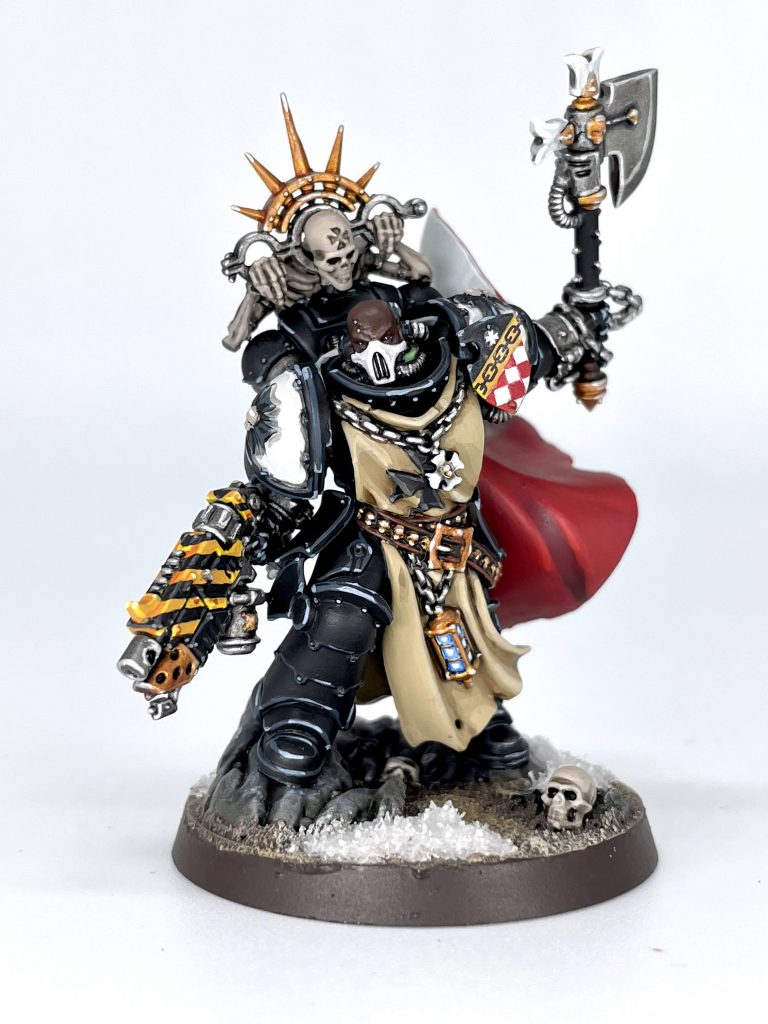
Turn Order
The biggest question here is “how do you resolve turns in a 3- or 4-player free-for-all environment? And that’s where the system takes an admirable gamble that may not pay off. Turn order in games of Treachery And Honour is determined before the game begins and is accomplished via a blind CP bid. Before the game players secretly bid up to 3 CP (why this is capped, I’m not sure), and roll that many dice, plus a free one, with their highest single roll being their score. The player who rolled the highest gets to go first, then the player who rolled second highest, and so on. The first tie-breaker is the number of CP bid – if we both roll a 6 but I spent 3CP on it and you spent 1CP, I still win – and then, if that doesn’t do it, players proceed to roll-offs. In games of Crusade, where players may often get 2-4 CP before a game as rewards, this is decent as a balancing factor, but it still locks you into a set order for the entire game. It also requires a bit more time and effort to sort out.
Greg: Just bid 3CP every time and fish for 6s, plus you’ll have the best odds on the first tie-breaker. First turn is a significant advantage in this game, and it’s not like it becomes less valuable when you might be eating three full shooting phases before getting to activate anything. The starting CP is helpfully increased from 3/6/12 to 4/6/14, so there’s no reason to hoard the things. I actually appreciate that they keep the same turn order every battle round, because I have zero interest in going through all this rigamarole five times a game.
Beanith: I really feel they dropped the ball on this one in one key area: you should have to determine Turn Order every battle round and not just once per game.
There’s also Reverse Turn Order which is, oddly enough, the Turn Order in reverse. This is mostly for choosing Deployment zones and setting up first. Similar rules are here to clarify the order of the Fight phase and morale checks, but it’s roughly what you’d expect.
There’s a change to table edges here that’s interesting: your “battlefield edge” is just the part of the table where your deployment zone intersects with the edge, rather than being one entire side of the table. I like this change, and think it makes sense for normal battles as well.
SRM: I agree with Beanith that the turn order should be determined every battle round. It’s a real bummer to know you’re not gonna push your dudes around for an hour + while 3 other folks run through their turns. I like bidding CP and rolling off though. It’s random but when you’re under on Crusade Points you’ll have more Command Points to spend, so the player that’s down on their luck will hopefully be able to affect the turn order positively.
TheChirurgeon: Yeah we solved this pretty well in the Apocalypse games we did where everyone gets a token numbered 1-5 and bids them every turn to go first. Hell, that’s not even our idea – it came from an issue of White Dwarf. They could have done something similar here. Even Greg, who hates bidding, could get behind the tokens system. I think.
Greg: I do! Tokens you at least have some control over, but Games Workshop friggin’ loves using complicated sequences of dice rolls for stuff.
TheChirurgeon: The one big issue they haven’t resolved satisfactorily here is the Fight phase. When you have more player turns, the Fight phase happens more times per battle round. That means a unit that normally fights twice per round if it gets stuck in will now fight 3-4 times. The rules call for resolving these fights in reverse player order with activations, which is fine, but this generally means that:
- The game will slow down a bit as every player may have activations every turn
- Your units are more likely to fight themselves out of combat earlier than you’d anticipate
- Units that double fight are going to be insanely powerful, since they can now fight up to 8 times per battle round in a 4-player game. Hello again, Drazhar and Berserkers.
Which isn’t to so say that these rules don’t work – this is certainly the most intuitive way to handle this – but I do worry about how it’s going to actually play.
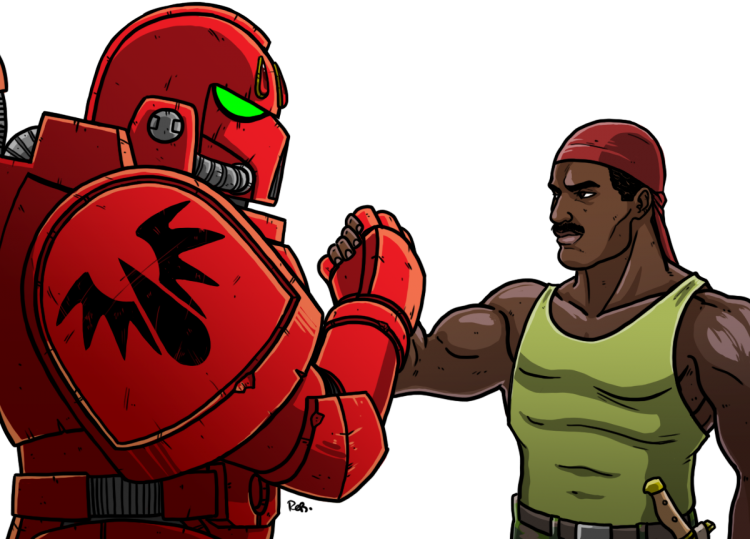
Alliances
In a first, this mission packet adds an entire new phase to the battle. At the start of the Battle Round, before Command Phases, there’s the Alliance Phase, and you’re allowed to get up to all manner of skullduggery here. The book specifically mentions bribing opponents to swap turn order, trading command points, or just asking for favors. This is, ironically or unironically, depending on your personal comfort with being a dirtbag, going to be the Friend-Maker phase, as there doesn’t appear to be any restrictions on double-crossing or lying to your erstwhile allies during it. Look, it says to be “creative” and if lying through your teeth isn’t creative I don’t know what is.
This is also where you allocate Underdog points.
SRM: I do like the Calvinball-level alliance rules. Want to barter your turn position for support? Trade real life favors? Trade command points? Fuck it, go for it. Interestingly, trading positions in the turn order is the only way to change the order of a turn here. How binding your agreements will be depends on whether or not you remain friends afterwards, and I’m here for it.
TheChirurgeon: Yeah, this is pretty neat, and I like that there’s a phase for doing this, but I’m not sure how this would stop me from wheeling and dealing at any point during the turn. The bigger question is “what do you actually have to offer an opponent, and why would you ever form an alliance?” I’m not sure there’s enough reason to do this in a game as laid out here.
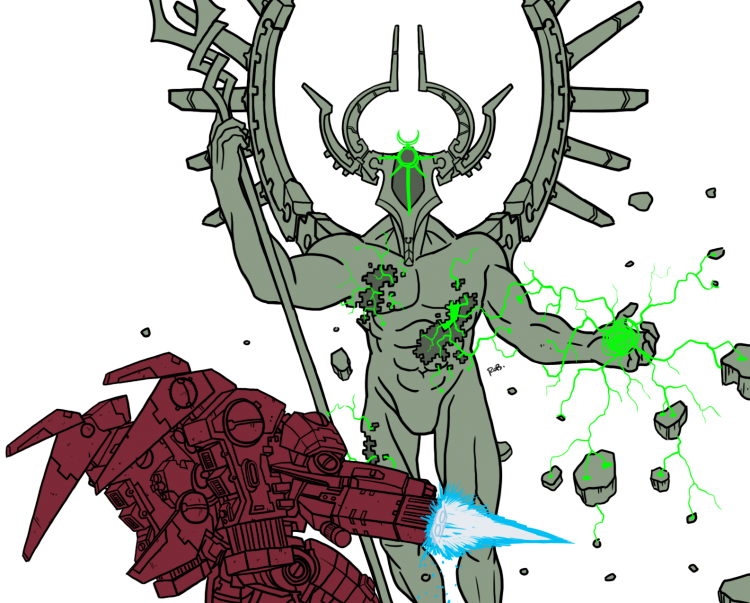
Underdogs
Whom amongst us hath not gotten pile-driven into hell during a multi-player game of warhammer? Underdog Points are an attempt to help with this. These points are earned in a few explicit ways: going last in the turn order, having the fewest Victory Points, or having had the most PL worth of your army destroyed. There’s also a designer’s note calling out that, you know what, rules aren’t real and this game type is operationalized insanity, so if you want to chuck more points out there, go nuts.
The bonuses are fine. I don’t think they make up for getting quadruple-crossed and having your entire army removed from play, but nothing is going to help there and they aren’t bad either. Any amount of Underdog points can be traded for CP, on a 1:1 ratio, or a single point can give your entire army Light Cover against shooting, Heavy Cover against melee, expanded Aura ranges, or auto-passing Combat Attrition. If you’re going last, you’ll get 1 point every turn, and having the equivalent of the old Prepared Positions stratagem, all game long, on an entire army, can significantly blunt the impact of that.
The boons are mostly one point each, but stack a few more points up, and for 3 you can mark a second unit for Greatness after the battle. Have fun with that, I guess.
SRM: The mix here is a nice balance between game-level bonuses and Crusade-level bonuses. None of them are busted good or totally worthless. Similar to the free-wheeling alliance system, the rules state you can give more Underdog points to a player if you think they’re really beefing it, provided it wasn’t their own fault. I think how fast and loose the rules are here really sets the tone for this entire way of playing.
TheChirurgeon: I like these quite a bit as a way to mitigate getting the last turn in the order, but remembering all of these may be a bit much.

Treacherous and Honourable Units
The Crusade meat of this system is the ability to tag units as either Honourable or Treacherous. Before every battle, in the Muster Armies step, players can choose to tag one for free, and there are 1RP Requisitions to tag additional 2 units as well. You can’t have both on the same unit, but there are no restrictions on mixing-and-matching in your Order of Battle or army. Making a unit treacherous or honourable gives them a keyword, and which gives them access to the following.
Battle Traits
There are three for Honourable units, and three for Treacherous units.
Honourable Dorks get Honourable Duelists, for +1 to hit in melee if they don’t split attacks. They could also take Staunch in the Face of Treachery, and auto-pass Attrition if they’re within 6” of an enemy, or 9” of a Treacherous enemy. The final nerd option is Coordinated Firepower, and it both kinda sucks and takes some explaining. You remember the Kill tallies from Crusade? Twice per game, if an enemy unit is destroyed, and this unit of herbs has done 5 or more wounds to it at some point, they get to count it toward their tally in addition to the people who did the work getting the credit. I’m not honestly sure this shouldn’t have been a global rule in Crusade, but ok. If you spread around the wealth of damage, you can get two thirds of an extra XP every game.
Cool Treachery Enthusiasts can choose between Backstabbers (+1 to wound in melee if the target is performing an Activity) or Distrustful of Nobility (-1AP in combat, or -2AP against an Honourable unit). My editors are telling me that I have to talk about Aura of Mistrust, which is a 3” -2 Ld debuff. Whatever.
Greg: I think these would be more in-character if they interacted more with their opposite numbers, but they’re certainly more useful for not having the restriction. They also have zero conditions on assigning them, just the keyword, so there’s nothing stopping you from making a bunch of Deathwing Knights swing at AP-3 or have a Night Lords unit projecting a -3Ld Aura.
SRM: Thematically, I like that I can make an army that basically has Keyword: Dirtbag. Having two more tables of Traits to roll on is yet more added complexity in a system already full of paperwork, but they’re at least pretty flavorful, if situational, traits.
TheChirurgeon: I feel like these should be things you earn by being a shithead, rather than things you just drop on your guys. This is the kind of thing a unit should pick up if it makes a Fall Back move then shoots you to death, or if you opt to charge an enemy character with a single character of your own and fight them one-on-one. I could see a GM giving these out.

Stratagems
The Stratagems in this section are split into two categories: Honourable and Treacherous, which mostly line up with the unit types mentioned above, e.g. a Treacherous Stratagem benefits a Treacherous unit.
All Part of the Plan is a stratagem that specifically benefits backstabbing, giving +1 to hit against another player’s unit provided they didn’t attack any of your units last turn. A Subtle Undermining is even nastier, all but disabling an enemy character’s aura abilities for a turn. Used at the right time, that could be devastating for 2CP. Suspicion Vindicated gives a Treacherous unit that destroys a unit a 6” aura of -1 to Combat Attrition, for 1CP.
Side By Side is an Honourable stratagem, where if your honourable character and someone else’s honourable character are within 6” of each other, they both get to re-roll 1s
to wound, against any target, for the entire battle round. This plays well if you have an alliance with that player, but can also be used against an enemy if you think you can dumpster them with your re-rolls before they get to use theirs. For 1CP, it might be useful in some situations, but it’s certainly not reliable enough to build around, since everything about it requires an opponent’s interaction. They also get access to Stand Firm, a kind of cut-rate Insane Bravery. For 1CP, if an Honourable unit passes morale, another unit within 6” of them can auto-pass their own test. Again, situational, at best, but it’s nice to get a cheaper and unlimited-use Insane Bravery. Finally, we have Enemy of my Enemy, which is just For The Greater Good.
Greg: It’s nice to see some new stratagems, not that this game really needed more of them. The Honourable ones take a lot of setting up – even Enemy of my Enemy – and don’t seem like they’ll see a lot of use. Treachery appears to be its own reward, with the ability to turn off (or at least substantially turn down) Auras or bonuses to hit a unit that didn’t attack you. Throwing the latter at a melee unit that spent turn 1 slogging up the board, or some nerds in cover doing Activities, is a great use of 1CP.
SRM: The balance between “cool new stratagems” and “I’m searching upwards of 4 books in a game to see if I have a stratagem for this” is tough. I honestly wish there was a deckbuilding mechanic for stratagems to cut down on this but I’ll get off my smooth-brained soapbox now. The Treachery ones are way more fun and useful on the regular. I do like the picture of Side By Side though; you and your friend’s noble heroes standing back to back and benefiting from it as they cut down enemy hordes is extremely cool.
TheChirurgeon: I also want a deckbuilding mechanic. In part because Greg has a visceral negative reaction to the suggestion.
Greg: Nothing is stopping you nerds from building a deck of Magic Cards for stratagems if you want to limit your options. Just leave me out of it.
Agendas
These are all just tallies that give you XP at the end, save for one. The tally ones are all either boring or too complicated, but Treacherous Betrayal is kind of cool for how easy it is to farm XP with: for every turn where you attack units from 2 or more enemy armies, add to your Betrayal tally. If you hit 4 on it, one unit can be treacher-ized for free, and then all treacherous units gain 2XP.
SRM: I think some of the tally-keeping ones can kind of dictate your alliances for you – if you’re gonna get XP for your honorable dudes killing their dishonorable dudes, it’d be silly not to do so. The mental load of keeping track of whomst is or isn’t honorable sounds like a pain in the ass though.
The Missions
True to their word, these are missions exclusively designed for multi-player battles. Each one has two maps, one for 3 players and another for 4. There are six missions each for Combat Patrol, Incursion, and Strike Force, and three for Onslaught.
Beanith: Nuh huh, no way is there anyone crazy enough to want to play a 4 player Onslaught level game. With 10,000+ points on the table, you might as well be playing Apocalypse at this point. You’ll even get to the fourth round before the day is over this way.
TheChirurgeon: Yeah seriously just play Onslaught at that point. I can maybe see how you’d do 2,500 points each in a 3-player game but that’s absolutely going to be pushing the absolute upper bound of what’s reasonable to play.
Given how quickly these games are going to descend into bedlam, Combat Patrol seems like the most reasonable way to attempt to play them. The maddest of the lot is Safeguard Dignitaries, and I love it so much. The four player version has deployment zones that are each a full table quarter, with zero dead space between them. Each player places two objectives in their deployment zone, representing an ambassador. Points are scored for:
- Having any objectives remaining in your deployment zone.
- Controlling any objectives.
- Murdering one of the other players’ ambassadors..
That’s right, this one starts with 8 objectives on the table, and players can do an Activity to remove one. Here’s the thing I love about this: you get 10 points for each of the above, and it caps at 30. It’s easy enough to protect one of your own, but you’re also free to go around air-holing VIPs to your heart’s content. You cannot, however, murder your own dignitaries, which would have been very cool. It’s basically Assassination but not tied to any particular model, which is a solid upgrade from “the worst non-Scouring mission in the game” to “playable chaos”.
Some of these seem tailor made to cause as much carnage as possible. The Swarm Rises wants players to hold objectives, only for those objectives to explode in mortal wounds as a swarm of critters overruns the battlefield.
TheChirurgeon: Incursion missions are also a great fit for this, since four 1,000-point armies add up to the same total as a 1on1 Strike Force game. I also feel like they give you a bit more freedom to actually make armies. These are pretty straightforward, though my favorite of the bunch is Buried Treasure, which has players scrambling to excavate a number of secret objectives.
Greg: There’s a fun Onslaught mission called Grand Demolition where players declare whether they’re here to blow up stuff or not, with an important note here that you are allowed to lie about which side you were on. Any player can plant an explosive charge, or defuse a charge, and after three of the four markers have two charges on them, the center of the board eats a ton of mortal wounds. At the end of the game, you declare which side you were actually on, and get points based on whether the big thing fell down or not. I like this one. All the players could be on the same team and just enjoy breaking stuff for a while, and it lends itself to some great themed tables, but mostly because it introduces a new mechanic to warhammer: lying. You can declare yourself a False Destroyer, and get progressive points for other Destroyers planting charges, then suddenly make a heel turn and defuse all the explosives at the end to score the end-game Protector points, all the while wondering if everyone else is running the same hustle. It’s buck wild and I think really leans into what Onslaught is supposed to do, which is “not make a lick of sense but be a fun ride”.
Final Thoughts
Beanith: I’m not going to lie, I am disappointed by this release but then it’s having to contend with memories of a home brew Triumph and Treachery I cobbled together for 8th Edition from the Warhammer Fantasy Triumph and Treachery released way back in 2013. That was perfect for a 3 to 6 player free for all with backstabbing, shenanigans, chaotic random turn orders and just a great way to finish off a day of 40k. So I may be a little guilty feeling wistfulness about those pre-covid afternoons. That said, this will do for when we have odd numbers at a games day and I’m looking forward to reminding my friends that the totally secret alliance we just entered into just means I’m going to backstab you from the front.
Greg: I think we’ve all tried variations on the house-rules for multiplayer games, and I appreciate that GW is attempting to codify them here into a real rules packet. I have to admit, I don’t see these getting played a lot, but I don’t think they’re bad at all and if your game group is already into the multiplayer concept, these rules offer a really solid way to play it. It’s kind of neat, but very much a niche product. If you frequently end up with an odd person out during your ham slams, give this a look. Otherwise, it’s fun but non-essential.
SRM: The added complexity to Crusade’s already dense amount of paperwork isn’t my favorite thing, but I do like multiplayer rules and scenarios being this solid and varied. I think the mission pack could be a lot of fun for a gaming group to have for those days when there’s an odd ‘ham out, and certainly would have come in handy a few times in my gaming career. It wouldn’t be hard to use them in a matched play game either, so if you’re the type who plays fairly casually, but isn’t doing a Crusade, I think there’s a decent amount of value here. I feel this is a good framework to jump off from for your own gaming group, even if you’re just using the scenarios and such for one-off Matched Play games.
TheChirurgeon: I’m not sure this does anything people weren’t already capable of doing on their own, but the Alliances phase and the way they’ve handled turn order aren’t bad. I wish there were more resources/things to trade – there seems to be very little you can realistically offer an opponent in most games, making the idea of forging alliances/bribing a player only useful in the context of scoring more XP, not accomplishing campaign goals. I see the temporary appeal but the hard work of creating incentives for an alliance falls on the campaign GM – having rewards for more than one player in a multiplayer game seems like the easiest solution here but all of the missions just have a single victor bonus.
If you’re looking for rules on how to play 3- and 4-player free-for-all games, you could do a lot worse than these rules, and even if you aren’t playing Crusade I think they work just fine for casual games where you have uneven teams or players. And if you’re a more involved GM looking to add these to a campaign, consider just lifting the missions and turn structure rules and leaving the rest on the cutting room floor.
Have any questions or feedback? Drop us a note in the comments below or email us at contact@goonhammer.com.
